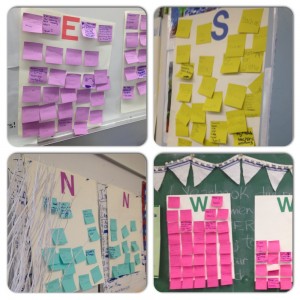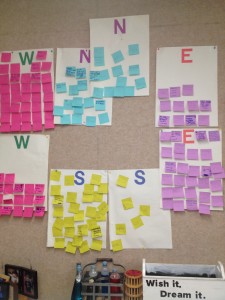Getting started on our science fair!
I chose to introduce the science fair using an activity called “Compass”.
It’s all part of the theory and practice that goes with Ron Ritchart’s- Making Thinking Visible project. I’ve been itching to try out some of the “thinking routines” since I read the book over the winter break and then attended the workshop.
I of course ended up adapting it quite a bit for my class but I think I hit the key goals of a “minds on” activity that provides documentation of learning. The compass was also perfect because the class had just recently started learning about maps.
This activity gave me tons of information about where the students are at before our science fair gets underway. I’m very serious about gathering student input and interest in the projects I do. I wanted the students in our class to have the opportunity to voice their thoughts right from the beginning.
Here is what the centres stand for:
N- is “Needs” – What do you think you will need to do the science fair project?
E- is “Excited”- What are you excited about for science fair?
S- is “Steps and Supports”- What steps will you need to take to be successful in your project? Who can support you?
W- is “Wonder”- What do you wonder about? In this case- what is a “W” question you might want to explore or learn about during the science fair.
These four directions got students thinking about how much time they would need, what questions they had, what they were interested in, who they would turn to for help, what they like… and it’s all documented for us to look at and think about!
The documentation is meaningful- it’s not for ornamental purposes- it informs and guides our future learning.



